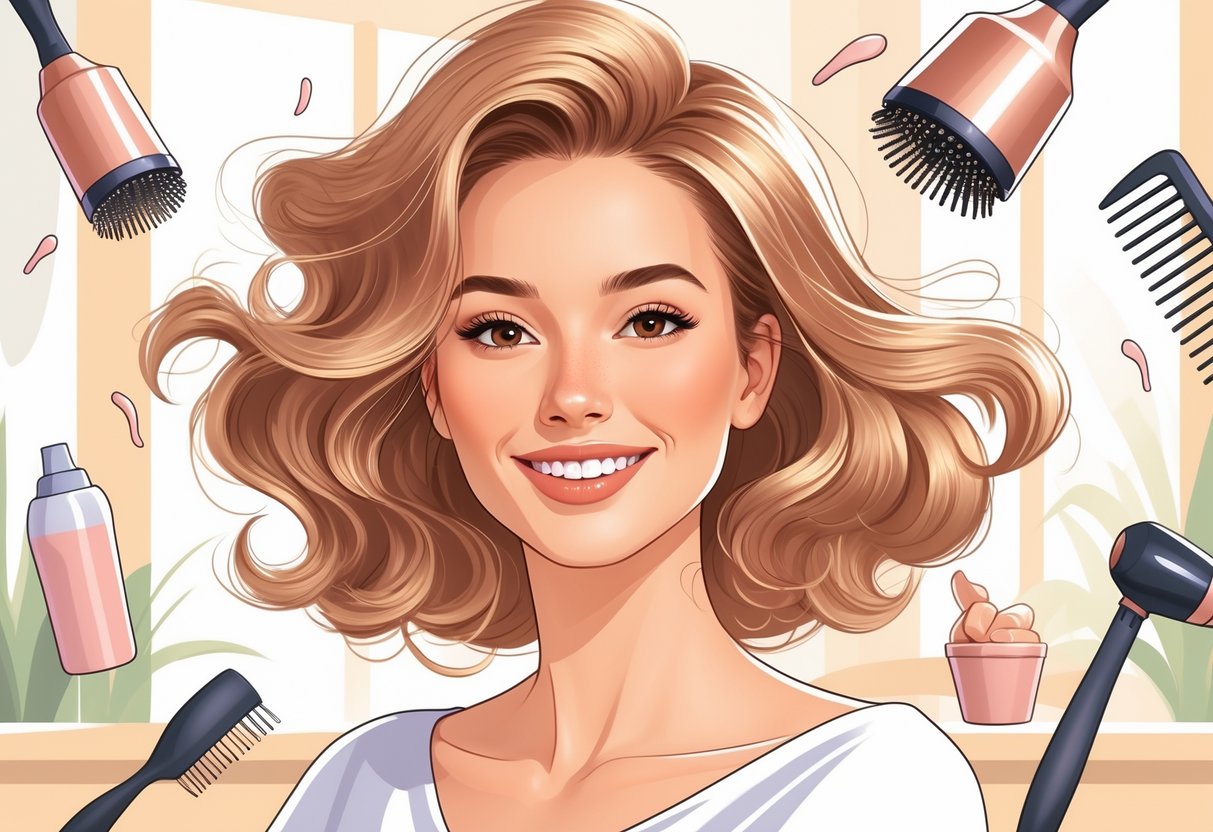
Fine hair often struggles to hold volume, leaving many women searching for solutions to achieve fuller, more textured styles.
The most effective way to create volume and texture for fine hair is by combining the right hair care routine, effective products, and simple styling techniques.
With a few targeted changes, anyone can achieve hair volume that lasts throughout the day and enhances natural texture.
Pro tips from experts recommend using volumizing shampoos and conditioners, applying texturizing sprays, and employing styling methods like blow drying upside down or incorporating Velcro rollers, as seen in these expert volumizing tips.
Simple adjustments in everyday hair care, such as avoiding heavy moisturizing products and choosing lightweight foams, can make a significant difference in boosting lift and body.
Understanding Fine Hair and Its Challenges
Fine and thin hair can be difficult to style due to its delicate structure and tendency to lack volume.
Achieving fullness and texture requires an understanding of the unique characteristics of fine hair and the factors that often lead to flatness or thinning.
Characteristics of Fine and Thin Hair
Fine hair refers to the diameter of each hair strand, not the number of hairs on the scalp.
These strands are smaller in circumference, making hair appear wispy or less dense.
Thin hair, meanwhile, is typically defined by having fewer hairs per square inch, which can create visible scalp and decreased overall fullness.
Fine hair is usually more fragile than coarser hair types.
It is prone to breakage, split ends, and can be weighed down easily by heavy styling products or excess oil.
Generally, this hair type also struggles to hold styles that require body or lift, making it challenging to maintain hair volume throughout the day.
Common Causes of Flatness
Several factors contribute to flatness in fine and thin hair.
Product buildup from conditioners, styling sprays, and oils can coat strands, leading to limpness.
Overwashing or insufficient rinsing may further aggravate the problem, causing hair to lay flat and look greasy faster.
Genetics play a significant role in hair thickness and density.
Hormonal changes, aging, stress, and certain health conditions may also cause hair to thin or lose its volume.
Environmental factors like humidity can make fine hair frizzy or lifeless.
Using inappropriate styling techniques — such as brushing when wet, or blow-drying without heat protection — can strip hair of natural lift.
Professional hair stylists recommend using lightweight volumizing products and techniques, as these are less likely to overwhelm delicate strands and promote bounce.
Impact of Hair Health on Volume
Hair health directly affects the appearance of volume and fullness in fine hair.
Nutritional deficiencies, scalp conditions, and excessive heat styling can all weaken strands, resulting in thinner, limper hair over time.
Keeping the scalp clean without over-drying is critical to maintaining hair volume, as a balanced scalp environment encourages healthy growth.
Maintaining hair moisture levels with lightweight hydrating products helps prevent breakage.
Regular trimming removes split ends, reducing the risk of hair shaft damage that can make hair look even thinner.
Gentle handling, protective hairstyles, and the avoidance of harsh chemicals also play a part in supporting the structure and resilience of fine or thin hair.
Heat styling should be done with care, as excessive use of hot tools can lead to protein loss and subsequent lack of body.
According to professional advice, nourishing the scalp and strands, combined with strategic styling, can help maximize the look of fullness and enhance natural volume.
Choosing the Right Hair Care Routine
A tailored hair care routine is essential to enhance volume and texture in fine hair.
The right combination of gentle cleansing, light conditioning, and smart washing strategies can make a noticeable difference in how full, bouncy, and manageable fine hair appears.
Selecting a Gentle Shampoo
Fine hair is particularly vulnerable to buildup and heaviness, so using a gentle, volumizing shampoo is critical.
Look for formulas labeled as “volumizing,” “weightless,” or “clarifying,” as these clean the scalp and strands without depositing heavy residues.
Consider alternating a clarifying shampoo once a week to clear away product buildup that can weigh hair down and make it look flat, as recommended by professionals in guides on fine hair care.
Avoid shampoos with nourishing oils or thick moisturizers that may be too rich for delicate hair textures.
When possible, wash only as needed rather than daily.
This helps prevent stripping natural oils, which can cause hair to appear limp.
Proper rinsing also ensures no shampoo remains on the scalp or hair, helping strands remain light and bouncy.
Importance of Lightweight Conditioner
Conditioner is essential, but for fine hair, using too much or the wrong kind can cause hair to go limp.
Opt for weightless conditioners that hydrate and detangle without coating the hair with heavy silicones or oils.
Look for labels that specify “lightweight,” “volumizing,” or “for fine hair.”
Apply conditioner only from mid-length to ends, avoiding the scalp.
This technique prevents roots from becoming oily and flat.
Using a small amount goes a long way, so with fine hair, less is often more.
If volume is the main concern, experts suggest dialing back the amount of conditioner or skipping it at the roots.
Try different routines to find the balance between soft, manageable strands and lasting lift.
Benefits of Double Shampooing
Double shampooing, also known as shampooing twice in one wash, can be highly effective for fine hair prone to buildup or oiliness.
The first wash removes styling products, natural oils, and impurities from the scalp.
The second wash cleanses more deeply and ensures the hair is fresh and light.
This practice is especially helpful if using volumizing or styling products, as it clears the way for them to work more efficiently.
According to hair professionals, double shampooing when using a volumizing shampoo can enhance lift at the roots and prolong fullness.
However, it’s important to monitor how often this is done.
Over-washing can lead to dryness, so double shampooing is best reserved for days when extra cleansing is needed or after using heavier products.
Always follow up with a lightweight conditioner to maintain softness without sacrificing volume.



